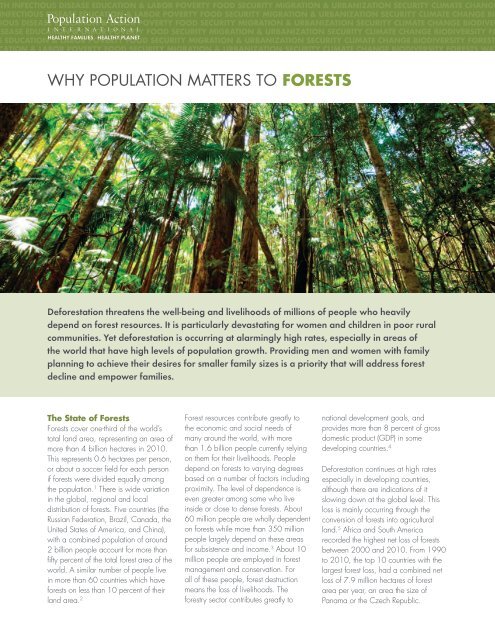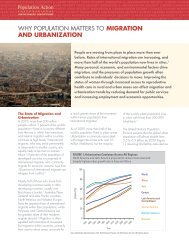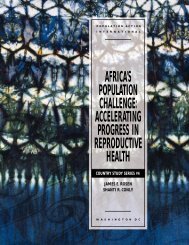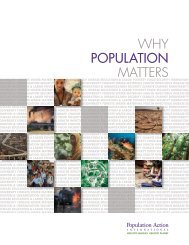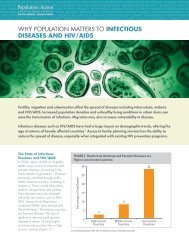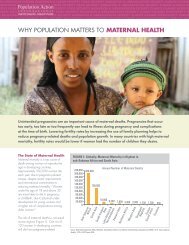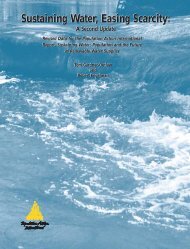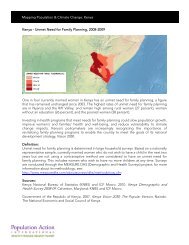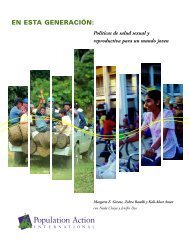WHY POPULATION MATTERS TO Forests - Population Action ...
WHY POPULATION MATTERS TO Forests - Population Action ...
WHY POPULATION MATTERS TO Forests - Population Action ...
- No tags were found...
You also want an ePaper? Increase the reach of your titles
YUMPU automatically turns print PDFs into web optimized ePapers that Google loves.
h Infectious Disease Education & Labor Poverty Food Security Migration & Urbanization Security Climate Changenfectious Disease Education & Labor Poverty Food Security Migration & Urbanization Security Climate Change Bioous Disease Education & Labor Poverty Food Security Migration & Urbanization Security Climate Change Biodiversease Education & Labor Poverty Food Security Migration & Urbanization Security Climate Change Biodiversity FohealthY FaMIlIes healthY PlanetEducation & Labor Poverty Food Security Migration & Urbanization Security Climate Change Biodiversity Forestation & Labor Poverty Food Security Migration & Urbanization Security Climate Change Biodiversity <strong>Forests</strong> WatWhy <strong>Population</strong> Matters <strong>TO</strong> <strong>Forests</strong>Deforestation threatens the well-being and livelihoods of millions of people who heavilydepend on forest resources. It is particularly devastating for women and children in poor ruralcommunities. Yet deforestation is occurring at alarmingly high rates, especially in areas ofthe world that have high levels of population growth. Providing men and women with familyplanning to achieve their desires for smaller family sizes is a priority that will address forestdecline and empower families.The State of <strong>Forests</strong><strong>Forests</strong> cover one-third of the world’stotal land area, representing an area ofmore than 4 billion hectares in 2010.This represents 0.6 hectares per person,or about a soccer field for each personif forests were divided equally amongthe population. 1 There is wide variationin the global, regional and localdistribution of forests. Five countries (theRussian Federation, Brazil, Canada, theUnited States of America, and China),with a combined population of around2 billion people account for more thanfifty percent of the total forest area of theworld. A similar number of people livein more than 60 countries which haveforests on less than 10 percent of theirland area. 2Forest resources contribute greatly tothe economic and social needs ofmany around the world, with morethan 1.6 billion people currently relyingon them for their livelihoods. Peopledepend on forests to varying degreesbased on a number of factors includingproximity. The level of dependence iseven greater among some who liveinside or close to dense forests. About60 million people are wholly dependenton forests while more than 350 millionpeople largely depend on these areasfor subsistence and income. 3 About 10million people are employed in forestmanagement and conservation. Forall of these people, forest destructionmeans the loss of livelihoods. Theforestry sector contributes greatly tonational development goals, andprovides more than 8 percent of grossdomestic product (GDP) in somedeveloping countries. 4Deforestation continues at high ratesespecially in developing countries,although there are indications of itslowing down at the global level. Thisloss is mainly occurring through theconversion of forests into agriculturalland. 5 Africa and South Americarecorded the highest net loss of forestsbetween 2000 and 2010. From 1990to 2010, the top 10 countries with thelargest forest loss, had a combined netloss of 7.9 million hectares of forestarea per year, an area the size ofPanama or the Czech Republic.
isease Education & Labor Poverty Food Security Migration & Urbanization Security Climate Change Biodiversityimate Change Biodiversity <strong>Forests</strong> Water Maternal Health Infectious Disease Education & Labor Poverty Food Secu& Labor Poverty Food Security Migration & Urbanization Security Climate Change Biodiversity <strong>Forests</strong> Water MatLinks between <strong>Population</strong>and <strong>Forests</strong>Demographic factors includingpopulation growth, density, distribution,migration, and urbanization areimportant drivers of deforestation.The top 10 countries experiencingthe greatest forest loss have largepopulations, many of which continueto grow rapidly (Table 1). Ingeneral, areas of high populationgrowth overlap with those that haveexperienced high forest loss over theyears (Figure 1).<strong>Population</strong> growth, density,and distributionEvidence shows that rapid populationgrowth, in combination with otherfactors, contributes to increasingdeforestation. 7 Small frontier farmers,living on the edge of forests, drivemuch of the developing world’sdeforestation by cutting down forestsfor settlement and food production.Table 1: <strong>Population</strong> Matters to Top 10 Countries with Net Loss of Forest AreaCountryAnnual Changeof Forest Area,2000–20101,000ha/yr<strong>Population</strong> (Millions)% 20102050ProjectedUnmetneedfor FPBrazil -2642 -0.49 194.9 222.8 6.0Australia -562 -0.37 22.3 31.4 n.aIndonesia -498 -0.51 239.9 293.5 9.1Nigeria -410 -3.67 158.4 389.6 20.2United Republic of Tanzania -403 -1.13 44.8 138.3 21.8Zimbabwe -327 -1.88 12.6 20.6 12.8Democratic Republicof the Congo-311 -0.2 66.0 148.5 24.4Mynamar -310 -0.93 47.9 55.3 19.1Bolivia -290 -0.49 9.9 16.8 20.2Venezuela -288 -0.60 28.9 41.8 N.A.Total -6,040 -0.53 825.6 1, 358.6n.a = Data not availableSource: Food and Agricultural Organization of the United Nations (FAO). 2010. Global Forest Resources Assessment 2010. Rome: FAO.; United Nations<strong>Population</strong> Division. 2009. World <strong>Population</strong> Prospects: The 2008 Revision. New York: UN <strong>Population</strong> Division.; UN <strong>Population</strong> Division. 2010. WorldContraceptive Use 2010. New York: UN <strong>Population</strong> Division.Figure 1: High <strong>Population</strong> Growth Overlaps with High Forest Loss, 1990-2010Countries with high rates of population growth are those where the population growth rate is above the median of all countriesbetween FIGURE 1: 2000 Change and in 2005. Forest This Area group and High includes <strong>Population</strong> all Growth countries Rates where 1990-2010 populations were estimated to grow by 1.33 percent annuallyCountries with high rates of population growth are those where the population growth rate is above the median of all countries between 2000 and 2005.or more over the period. These maps utilize the medium scenario of the United Nations long-range population projections,This group includes all countries where populations were estimated to grow by 1.33 percent annually or more over the period. These maps utilize thewhich medium assumes scenario that of the fertility United Nations rates in long-range all countries population stabilize projections, at replacement which assumes level. that 6fertility rates in all countries decline below andeventually return to replacement level. 6Percentage Change in Forest AreaHigh <strong>Population</strong> Growth RateNo Data-75 to -25%-25 to 0%No Change0 to 25%25 to 150%150 to 250%Sources: Food and Agricultural Organization of the United Nations (FAO). 2010. Global Forest Resources Assessment 2010. Rome: FAO.; United Nations <strong>Population</strong> Division. 2009. World <strong>Population</strong> Prospects: The 2008 Revision.New York: UN <strong>Population</strong> Division.
Climate Change Biodiversity <strong>Forests</strong> Water Maternal Health Infectious Disease Education & Labor Poverty Food Son & Urbanization Security Climate Change Biodiversity <strong>Forests</strong> Water Maternal Health Infectious Disease Educativerty Food Security Migration & Urbanization Security Climate Change Biodiversity <strong>Forests</strong> Water Maternal HealEndnotes1 Food and Agriculture Organization of the United Nations (FAO). 2010. Global ForestResources Assessment 2010. Rome: FAO.2 FAO. 2010.3 World Bank. 2004. Sustaining <strong>Forests</strong>: A Development Strategy. Washington DC:World Bank.4 Food and Agriculture Organization of the United Nations (FAO). 2006. Global ForestResources Assessment 2005: Progress Towards Sustainable Forest Management.Rome: FAO.5 FAO. 2010.6 United Nations <strong>Population</strong> Division. 2009. World <strong>Population</strong> Prospects: The 2008Revision. New York: UN <strong>Population</strong> Division.7 Pan, W, D Carr, A Barbierri, R Bilsborrow and C Suchindran. 2007. “Forest Clearingin the Ecuadorian Amazon: A Study of Patterns Over Space and Time.” <strong>Population</strong>Research and Policy Review 26:635-659.8 Geist, H J and E F Lambin. 2002. “Proximate Causes and Underlying Driving Forcesof Tropical Deforestation.” Bioscience 52(2): 143-150.9 Rosero-Bixby, L and A Palloni. 1996. "<strong>Population</strong> and Deforestation in Costa Rica."CDE Working Paper No. 96-19. Madison: 1996.10 Carr, D, L Sutter and A Barbieri. 2006. “<strong>Population</strong> Dynamics and TropicalDeforestation: State of the Debate and Conceptual Challenges.” <strong>Population</strong> andEnvironment 27:89-113.11 Barreto, P, C Souza, R Nogueron, A Anderson, R Salamao and J Wiles. 2006.Human Pressure on the Brazilian Amazon <strong>Forests</strong>. Washington DC: World ResourcesInstitute (WRI).12 Ramankutty, N, JA Foley and NJ Olejniczak. 2002. “People on the Land: Changes inGlobal <strong>Population</strong> and Croplands during the 20 th Century.” Ambio 31(3): 251-257.13 Food and Agriculture Organization of the United Nations (FAO). 2008. <strong>Forests</strong> andEnergy: Key Issues. Rome: FAO.14 FAO. 2010.15 Millenium Ecosytem Assessment. 2005. Ecosystems and Human Well-BeingBiodiversity Synthesis. Washington DC: World Resources Institute (WRI).16 Sherbinin, A, D Carr, S Cassels and L Jiang. 2007. “<strong>Population</strong> and Environment.”The Annual Review of Environment and Resources 32: 345-373.17 Leahy, E, R Englelman, C Vogel, S Haddock and T Preston. 2007. The Shape ofThings to Come. Washington, DC: PAI.18 Geist and Lambin. 200219 Carr, Sutter and Barbieri. 2006.20 Carr, Sutter and Barbieri. 2006.21 DeFries, R, T K Rudel, M Uriarte and M Hansen. 2010. “Deforestation Driven byUrban <strong>Population</strong> Growth and Agricultural Trade in the Twenty-First Century.” NatureGeoscience 3: 178-181.; Lambin, E F and P Meyfroidt. 2011. “Global Land UseChange, Economic Globalization, and the Looming Land Scarcity.” Proceedings of theNational Academy of Sciences 108: 3465-3472.22 United Nations <strong>Population</strong> Division. 2010. World Urbanization Prospects: The 2009Revision. New York: UN <strong>Population</strong> Division.23 DeFries, Rudel, Uriate and Hansen. 2010.24 Carr, Sutter, and Barbieri. 2006.healthY FaMIlIes healthY Planet1300 19th Street, NW I Second Floor I Washington, DC 20036 USATel: +202.557.3400 I Fax: +202.728.4177 I wwww.populationaction.org I Email: pai@popact.org© <strong>Population</strong> <strong>Action</strong> International, 2011. Contents of this and accompanying materials may be reproduced provided <strong>Population</strong> <strong>Action</strong> International is acknowledged as the source.


